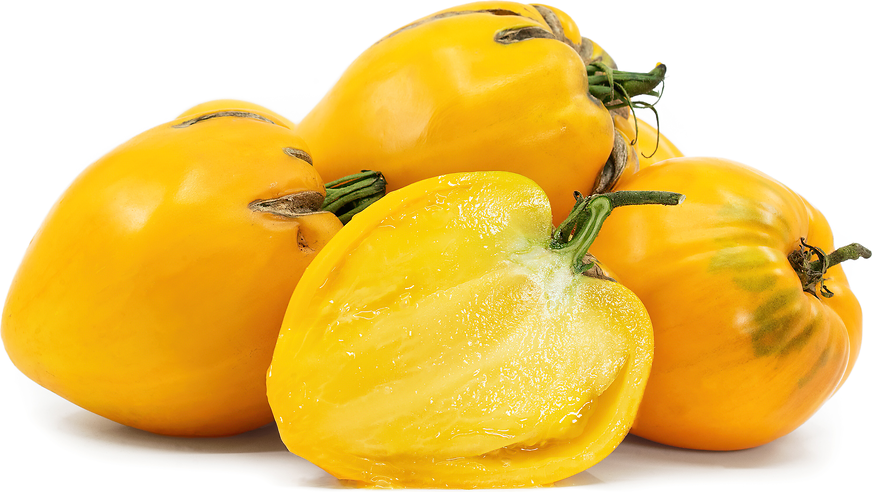


Golden King of Siberia Tomatoes
Estimated Inventory, lb : 0
Description/Taste
Golden King of Siberia tomatoes are a large variety, capable of weighing 6 to 18 ounces, and have a distinct, heart-like shape with broad, rounded shoulders curving to a slightly tapered base. The skin is smooth, semi-thin, and glossy, ripening to a rich, golden yellow-orange with some green patches around the stem. Underneath the surface, the yellow flesh is dense, tender, and aqueous with a smooth consistency. The flesh also encases a few pockets of seeds, but the variety is known for being nearly seedless and is primarily filled with solid flesh. Golden King of Siberia tomatoes have low acidity, creating a mild and balanced, sweet-tart, fruity flavor.
Seasons/Availability
Golden King of Siberia tomatoes are available in the summer through early fall.
Current Facts
Golden King of Siberia tomatoes, botanically classified as Solanum lycopersicum, are a rare, oxheart variety belonging to the Solanaceae or nightshade family. Oxheart is a category of tomatoes with a large size, dense flesh, and tender consistency with a loose, heart-like shape. Golden King of Siberia tomatoes were introduced into the United States from Russia in the early 21st century, and the varietal name is a general descriptor created to encompass two similar heirloom Russian tomato varieties that are sold under the same name. Within the United States, the brightly colored cultivar is not commercially cultivated and is reserved to small farms and home gardens. Golden King of Siberia tomatoes are a mid-season, prolific variety with resistance to disease, drought, and temperature changes. The tomato plants also have characteristic, wispy leaves, which provide an unusual contrast to the large fruits creating ornamental appeal in gardens.
Nutritional Value
Golden King of Siberia tomatoes are an excellent source of vitamin C, an antioxidant that strengthens the immune system and reduces inflammation. The tomatoes are also a good source of folate, a B vitamin that helps build genetic material within the body and provides lower amounts of potassium, manganese, copper, phosphorus, iron, and zinc.
Applications
Golden King of Siberia tomatoes are best suited for both raw and cooked applications, including grilling, roasting, and simmering. The large, dense tomatoes are valued for their meaty flesh and can be eaten fresh, off-the-vine, or sliced and layered onto caprese. Golden King of Siberia tomatoes can also be cut and tossed into salads, chopped into salsa, blended into juices, or layered into sandwiches. In addition to fresh applications, Golden King of Siberia tomatoes can be stuffed and baked, simmered into pizza and pasta sauce, or incorporated into curries, stews, and soups. The tomatoes can also be grilled for a smoky addition to burgers or cooked and canned for extended use. Golden King of Siberia tomatoes pair well with herbs such as basil, cilantro, mint, oregano, and parsley, roasted meats such as poultry, beef, and pork, seafood, zucchini, potatoes, bell peppers, arugula, and aromatics including ginger, garlic, and onions. Whole, unwashed Golden King of Siberia tomatoes will keep 2 to 5 days when stored at room temperature away from direct sunlight.
Ethnic/Cultural Info
In the United States, there are currently hundreds of Russian tomato varieties offered in seed catalogs with distinct flavors, shapes, and colors, but the majority of these varieties weren’t available in the country until the late 20th century. The desire for Russian tomatoes began in the summer of 1981 when horticulturist and writer Ron Driskill published a story about ten tomato seeds smuggled out of Siberia. The newly introduced seeds were sold as Siberian tomatoes and were heavily marketed as a variety to “beat all others.” With increasing interest and buzz surrounding the tomatoes, other horticulturalists began planning trips to Russia and slowly smuggled multiple varieties out of the country for cultivation within the United States. During this time, Russia was also experiencing a food shortage, and families were growing their own produce in order to have flavorful, healthy ingredients. Many of the heirloom tomato varieties collected for cultivation in the United States were seeds gathered from Russian families who had been gardening for multiple generations. Once introduced into American gardens, Russian tomato cultivars quickly gained approval by tomato enthusiasts for their pronounced flavors with reliable growth characteristics, leading them to be some of the most popular varieties sold in modern-day seed catalogs.
Geography/History
Golden King of Siberia tomatoes have a mysterious, somewhat convoluted history. Experts believe the cultivar is a combination of two commercial varieties from Russia, the korol sibiri and zolotoy korol tomato. The varieties were sent to Baker Creek Heirloom Seeds through seed exchange partner Valery Popenko, and when test grown, Baker Creek determined the cultivars to be so similar that they could be categorized under one name. The name Golden King of Siberia was created from a combination of korol sibiri, roughly translating from Russian to mean “King of Siberia,” and zolotoy korol translating to “Golden king.” Golden King of Siberia tomatoes were released to American markets in 2010 and are sold primarily in seed form through online catalogs. The variety is not commercially grown and is cultivated in limited quantities through home gardens and small farms for farmer’s markets.
Recipe Ideas
Recipes that include Golden King of Siberia Tomatoes. One




